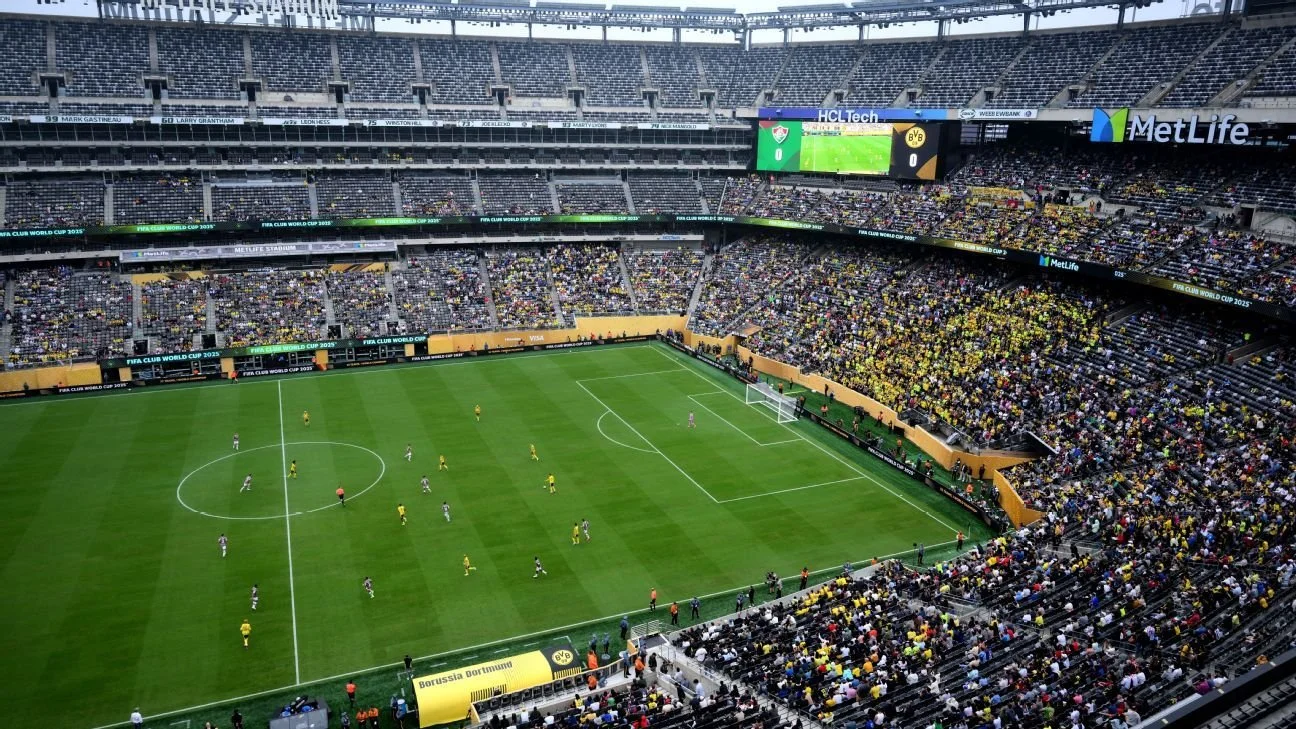FIFA's Empty Seats Problem: Why Smarter Demand Forecasting Matters
FIFA's last-minute ticket price slashes for the Club World Cup semi-final between Chelsea and Fluminense in New Jersey have made headlines for all the wrong reasons.
Originally priced at $474, tickets were cut to just $13.40 over the weekend. The shift, intended to avoid another match played in front of rows of empty seats, reflects a growing challenge for event organisers: how to align pricing with real demand.
Dortmund vs Fluminense at MetLife Stadium during the FIFA Club World Cup — visible gaps in the upper tiers reveal the real impact of poor demand prediction and misaligned pricing strategy.
What happened?
FIFA's expanded 32-team Club World Cup, hosted for the first time in the United States, has struggled to fill stadiums. Real Madrid drew 76,611 fans at MetLife for their quarter-final win over Borussia Dortmund. But other fixtures have floundered: Fluminense vs Ulsan brought in just 29,321; Palmeiras vs Al Ahly only 35,179.
Attendance for Chelsea vs Fluminense did improve, eventually reaching 70,556 — a marked rise likely influenced by the sharp ticket price drop. Yet fans who paid nearly $500 for a ticket now saw those same seats offered for under $15, with no indication of compensation. FIFA has yet to comment on refunds or credits for those affected.
This isn’t just a case of overpricing. It’s a failure of prediction.
Why Predictive Demand Matters
If demand had been forecast accurately, prices could have been set more appropriately from the outset, ensuring attendance matched expectations and fans felt their purchases were fair. Instead, we saw erratic swings, late discounts and confused messaging.
This is where ActDIvate's Movement Intelligence™ framework, and its proprietary STREAM platform, offer critical value. STREAM blends 20+ near-time data sources using machine learning and statistical analysis to help clients understand demand intent, footfall projections and commercial impact.
For FIFA, such intelligence could have shown:
Low regional interest in non-Real Madrid games
High price sensitivity amongst casual US-based football fans
Insufficient community engagement or local partnerships to drive turnout
More importantly, it would have:
Prevented last-minute pricing U-turns
Maintained price integrity and buyer confidence
Aligned ticket supply and demand more effectively
Let’s break this down further.
Where & When: Spatial Demand Heatmaps
STREAM can help identify where and when the swell in demand will occur, broken down by city, region and venue perimeter. In a city like New York, STREAM could model:
Footfall density around MetLife vs alternative venues
Demand intent based on booking trends, search data and behavioural proxies
Traffic and route congestion patterns pre- and post-match
This informs both pricing strategy and crowd logistics.
Avoiding Empty Seats
The most visible symptom of poor demand forecasting? Empty seats. It’s bad optics for TV, bad business for sponsors and bad faith for fans.
STREAM’s Event Indexing and Demand Intent analysis would have identified likely attendance per match well in advance. This would allow organisers to:
Adjust marketing spend to bolster weaker fixtures
Offer early-bird pricing calibrated to demand bands
Engage communities more likely to attend at appropriate price points
Dynamic pricing is not the problem. Mismatched dynamic pricing is.
Optimising Workforce and Inventory
Businesses that stock up based on projected demand avoid both undersupply (lost sales) and oversupply (wastage).
With STREAM, hospitality groups around MetLife could have prepared for:
The expected 76,000 Real Madrid fans vs the <30,000 Fluminense matchgoers
Adjusting staffing rotas to match demand surges
Releasing or reallocating surplus inventory (e.g. redirecting beer stock)
Dynamic Planning & Resilience
Governments and organisers using STREAM could model resilience by:
Planning crowd flow measures only for expected peak games
Allocating emergency services and public transport support accordingly
Minimising environmental impact by right-sizing infrastructure usage
A Model for Smarter Cities and Event Hosts
Beyond football, the same logic applies to concerts, festivals, political rallies, city centre activations and public infrastructure rollouts.
With ActDIvate, cities, businesses and organisers can:
Set the right prices based on real-time data
Allocate staffing, transport and inventory where demand is real
Plan in advance rather than firefight with last-minute slashes
FIFA’s missteps demonstrate what happens without that layer of insight. But the future doesn’t have to repeat the past.
What STREAM Could Have Revealed
Pre-tournament:
Top metro areas by intent
Ticket price elasticity by segment
Competing events during the same window
During the tournament:
Real-time footfall index by venue zone
Spend-per-capita estimations around the stadium perimeter
Swings in demand based on team progression
Helping to Solve FOMO for Organisers
Just as fans experience FOMO over sold-out concerts, organisers experience it when faced with half-empty venues and missed revenue. A ticket priced too high without the demand to support it leads to exactly the situation FIFA tried to fix with $13 seats.
With ActDIvate’s Movement Intelligence™, event hosts gain access to:
Personalised inputs – local events, capacity, tourist activity
Recommended outputs – pricing bands, marketing allocations, inventory needs
Predictive modelling – scenario analysis for high and low turnout cases
Key Use Cases Recap:
Set the right prices: Avoid overpricing that leads to empty seats
Optimise staffing: Match your workforce to peak footfall
Stock correctly: Avoid running out or overordering
Support sustainable operations: Plan transport and utilities with real data
Maximise profit: Align pricing with willingness to pay
The Lesson for Future Events
The 2025 Club World Cup may yet deliver excitement on the pitch — including moments like mic’d-up referees reversing penalties in front of 70,000 fans — but it has already delivered a lesson off it: pricing without demand insight is a risk.
As we look toward the 2026 men’s World Cup co-hosted by the US, Canada and Mexico, demand forecasting must move to the forefront of planning.
ActDIvate’s STREAM platform helps organisations move from reactive to predictive. From pricing panic to operational clarity.
Because pricing is not a lever to pull at the last minute. It’s a strategy to build on a foundation of demand intelligence.
Let’s stop guessing. Let’s start predicting.

